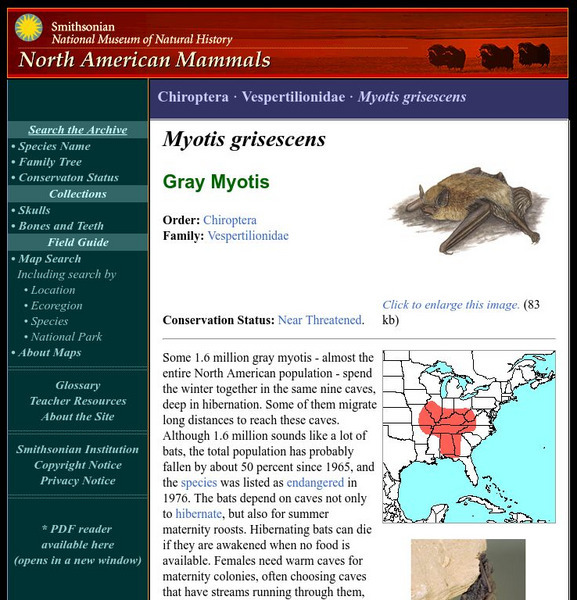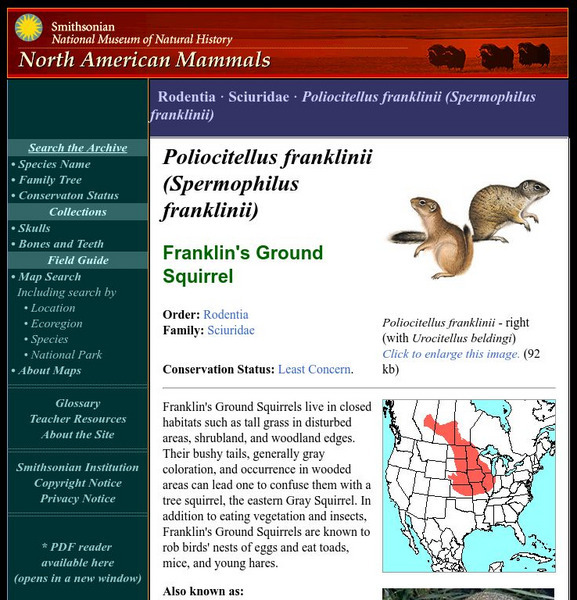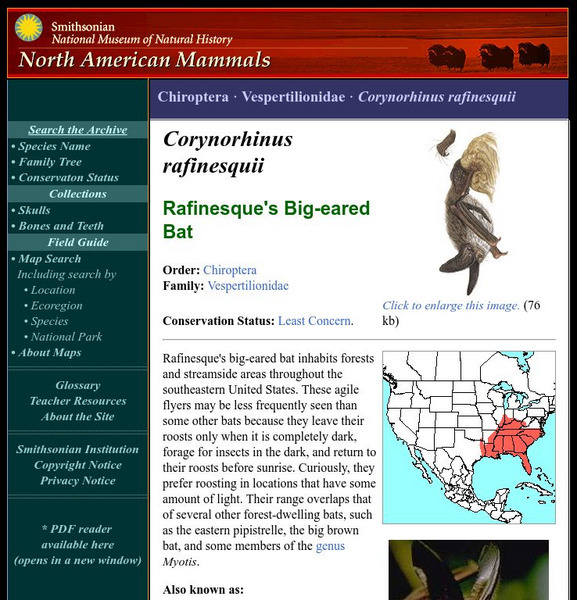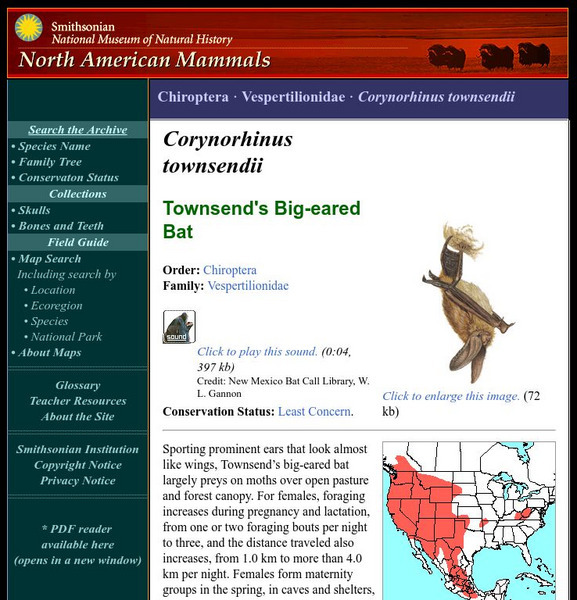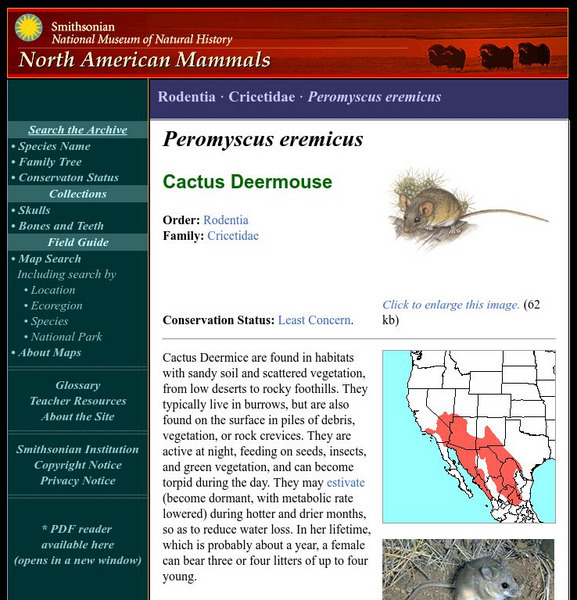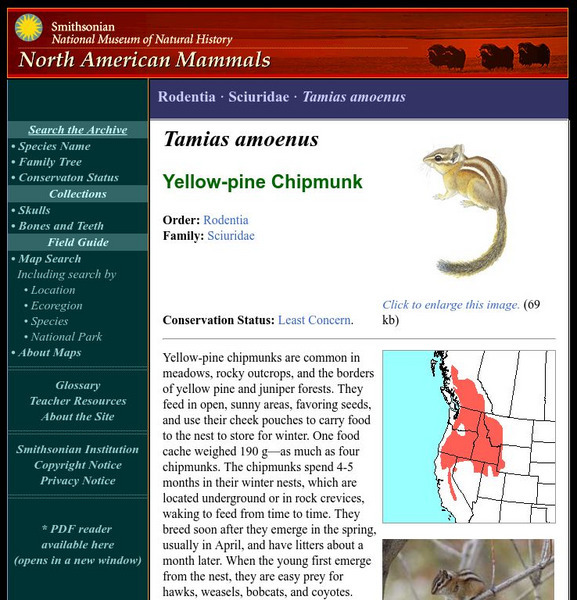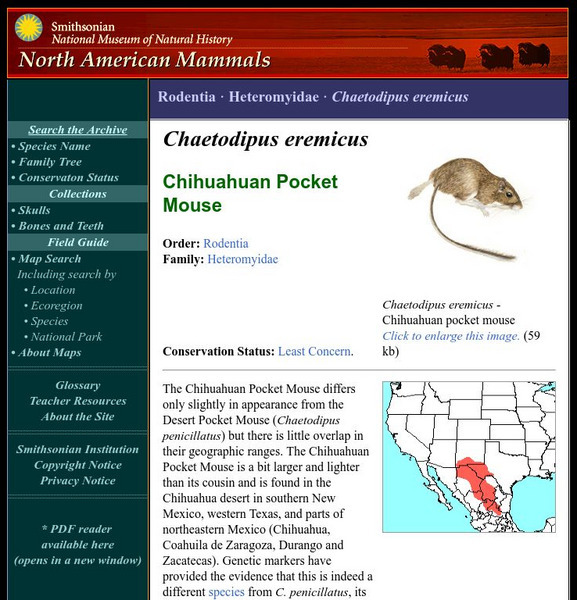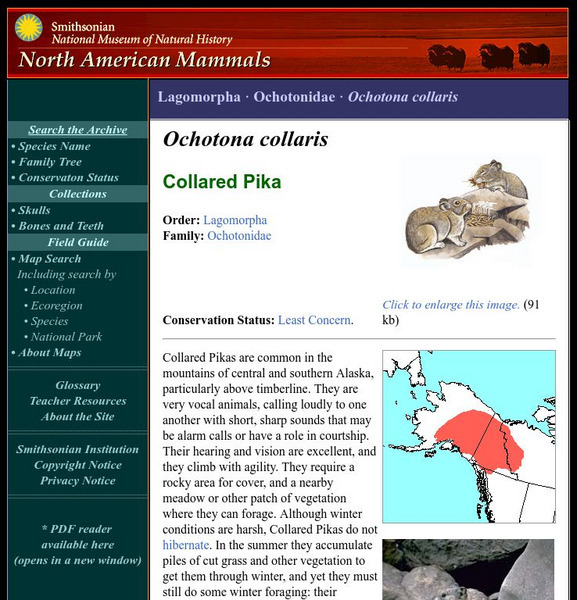Smithsonian Institution
National Museum of Natural History: American Mammals: Fisher
The Fisher is a forest-loving predator that eats anything it can catch, usually small-to-medium-sized rodents, rabbits, hares, and birds. It also eats carrion. Learn more about the Martes pennanti, more commonly known as a Fisher, in...
Smithsonian Institution
National Museum of Natural History: American Mammals: Ghost Faced Bat
Ghost-faced bats forage exclusively on large-bodied moths, and are strong, fast fliers. They spend their days in caves or abandoned mine shafts, and emerge soon after dark to fly to the arroyos and canyons where they forage. Learn more...
Smithsonian Institution
National Museum of Natural History: American Mammals: Gray Myotis
Some 1.6 million gray myotis - almost the entire North American population - spend the winter together in the same nine caves, deep in hibernation. Learn more about the Myotis grisescens, more commonly known as a Gray Myotis, in this...
Smithsonian Institution
National Museum of Natural History: American Mammals: Eastern Pipistrelle
Not as small as its western cousin, the eastern pipistrelle weighs in at 6 to10 g and is comparable in size to many bats in the family Vespertilionidae. Eastern pipistrelles are stronger fliers than western pipistrelles, and some migrate...
Smithsonian Institution
National Museum of Natural History: American Mammals: Franklin's Ground Squirrel
Franklin's Ground Squirrels live in closed habitats such as tall grass in disturbed areas, shrubland, and woodland edges. Their bushy tails, generally gray coloration, and occurrence in wooded areas can lead one to confuse them with a...
Smithsonian Institution
National Museum of Natural History: American Mammals: Desert Woodrat
Desert Woodrats inhabit scrublands in desert and semi-desert areas. Unlike some other rodents living in regions with limited water resources, the Desert Woodrat does not have water-conserving physiological adaptations. Learn more about...
Smithsonian Institution
National Museum of Natural History: American Mammals: Mountain Pocket Gopher
Mountain Pocket Gophers live in meadows, pastures, and rocky slopes, in pine, fir, spruce, and hemlock forests at elevations above 1,545 m. They are active all year, and like other pocket gophers, they are solitary. Learn more about the...
Smithsonian Institution
National Museum of Natural History: American Mammals: Western Red Bat
This close cousin to the eastern red bat (Lasiurus borealis) is genetically distinct. These bats are found along the west coast and the southwestern US and into Mexico where they are thought to hibernate in the winter. Learn more about...
Smithsonian Institution
National Museum of Natural History: American Mammals: Rafinesque's Big Eared Bat
Rafinesque's big-eared bat inhabits forests and streamside areas throughout the southeastern United States. These agile flyers may be less frequently seen than some other bats because they leave their roosts only when it is completely...
Smithsonian Institution
National Museum of Natural History: American Mammals: Townsend's Big Eared Bat
Sporting prominent ears that look almost like wings, Townsend's big-eared bat largely preys on moths over open pasture and forest canopy. For females, foraging increases during pregnancy and lactation, from one or two foraging bouts per...
Smithsonian Institution
National Museum of Natural History: American Mammals: Pallid Bat
Common throughout its range, the pallid bat occurs in arid and semi-arid regions throughout northern Mexico and the western United States. Pallid bats eat beetles, grasshoppers, and moths, and they forage for slow-moving prey, such as...
Smithsonian Institution
National Museum of Natural History: American Mammals: Steller Sea Lion
Steller sea lions are divided into two groups for conservation purposes. Those that live around Alaska and Russia are classified as endangered. Learn more about the Eumetopias jubatus, more commonly known as a Steller Sea Lion, in this...
Smithsonian Institution
National Museum of Natural History: American Mammals: Long Eared Myotis
With its long, luxurious fur, which can range in color from dark brown to pale yellow, and its large, coal-black ears, the long-eared myotis is a striking animal. Long-eared myotis prefer roosting in rock outcroppings and dead trees....
Smithsonian Institution
National Museum of Natural History: American Mammals: Brush Deermouse
Brush Deermice occupy rocky and brushy or forested environments in which rock ledges, piles of brush, fallen trees, and boulders offer shelter and denning sites. Although they are reportedly good climbers, they only occasionally build...
Smithsonian Institution
National Museum of Natural History: American Mammals: Cactus Deermouse
Cactus Deermice are found in habitats with sandy soil and scattered vegetation, from low deserts to rocky foothills. They typically live in burrows but are also found on the surface in piles of debris, vegetation, or rock crevices. Learn...
Smithsonian Institution
National Museum of Natural History: American Mammals: Yellow Pine Chipmunk
Yellow-pine chipmunks are common in meadows, rocky outcrops, and the borders of yellow pine and juniper forests. They feed in open, sunny areas, favoring seeds, and use their cheek pouches to carry food to the nest to store for winter....
Smithsonian Institution
National Museum of Natural History: American Mammals: California Pocket Mouse
California Pocket Mice eat seeds, insects, and sometimes green leaves. Like other pocket mice in the genus Chaetodipus, they scurry around on all four feet (unlike kangaroo rats, which are in the same family of rodents, and which hop on...
Smithsonian Institution
National Museum of Natural History: American Mammals: Chihuahuan Pocket Mouse
The Chihuahuan Pocket Mouse differs only slightly in appearance from the Desert Pocket Mouse (Chaetodipus penicillatus) but there is little overlap in their geographic ranges. The Chihuahuan Pocket Mouse is a bit larger and lighter than...
Smithsonian Institution
National Museum of Natural History: American Mammals: Collared Pika
Collared Pikas are common in the mountains of central and southern Alaska, particularly above the timberline. They are very vocal animals, calling loudly to one another with short, sharp sounds that may be alarm calls or have a role in...
Smithsonian Institution
National Museum of Natural History: American Mammals: Arizona Gray Squirrel
Walnuts are a favorite food of Arizona Gray Squirrels, and when they find an abundance, the squirrels soon stain their faces, paws, and undersides a distinct brownish-orange from walnut juice. Other foods eaten may include fungi, acorns,...
Smithsonian Institution
National Museum of Natural History: American Mammals: Blainville's Beaked Whale
Blainville's beaked whale is found worldwide in warm temperate to tropical waters. Small pods of 3-7 whales have been seen off Hawaii in waters 700 to 1,000 m deep, near much deeper water. Learn more about the Mesoplodon densirostris,...
Smithsonian Institution
National Museum of Natural History: American Mammals: Arctic Fox
An animal that does not begin to shiver until temperatures reach -70 C, the arctic fox is one of the most superbly cold-adapted mammals. Its dense, multi-layered coat, which is several inches thick during winter, provides excellent heat...
Smithsonian Institution
National Museum of Natural History: American Mammals: Brown Lemming
Unlike Norwegian Lemmings, Brown Lemmings do not migrate en masse when they overpopulate their homes in the treeless regions of the north, but they do tend to wander. These are stout-bodied, herbivorous rodents with extremely short...
Smithsonian Institution
National Museum of Natural History: American Mammals: Arctic Hare
The beautiful Arctic Hare has a far northerly distribution in the tundra of Greenland and Canada. Arctic Hares are larger, heavier, and more thickly furred than Snowshoe Hares. Learn more about the Lepus arcticus, more commonly known as...


